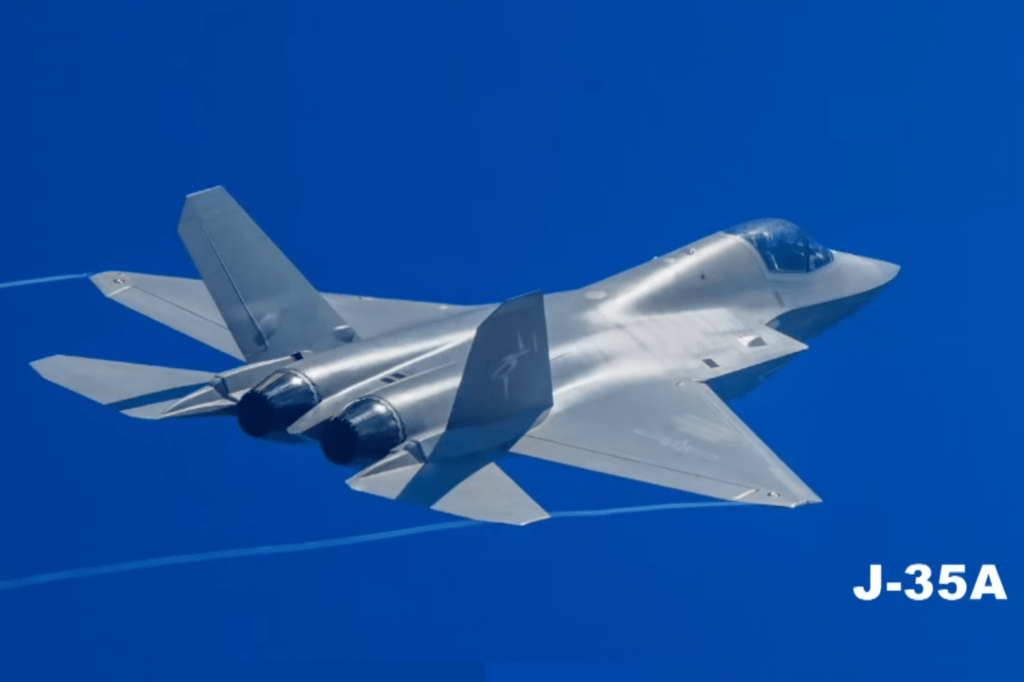The J-35A is the People’s Liberation Army Navy’s (PLAN’s) newest stealth fighter that has enhanced stealth capabilities and is holistically expected to further strengthen China’s naval power. China’s journey toward developing advanced stealth fighters has marked a significant leap in its military modernization efforts. Following the introduction of the J-20 as the first fifth-generation stealth fighter for the People’s Liberation Army Air Force (PLAAF), the J-35A now marks a parallel evolution for the PLAN as the growing military power’s second fifth-generation stealth fighter.

Following the introduction of the J-15, China’s first carrier-based fighter, the J-35A, whose most significant feature is its enhanced stealth capabilities, is expected to further strengthen China’s naval power as the PLAN moves quickly to extending its naval reach, particularly in the Indo-Pacific region, and equipping its second indigenous Type 003 carrier, the Fujian, and future carriers models with a viable stealth platform for the next generation of combat scenarios.
Publicly available specifications from China’s state media suggest the J-35A features twin engines, low observability, and enhanced operational versatility—capabilities that could make it a formidable competitor in its class.
The J-35A made its first public appearance at the 2024 Zhuhai Airshow mid-November 2024. Official Chinese media highlighted the platform as a testament to the country’s growing expertise in stealth technology and its commitment to self-reliance in military innovation. The airshow served as a platform for Beijing to demonstrate its progress in developing a viable carrier-based stealth fighter, particularly as the PLAN ramps up the operational readiness of its aircraft carriers fleets, particularly the Type-003 Fujian, PLAN’s first catapult-equipped carrier.
On December 19, 2024, Pakistan is reported to procure 40 J-35A from its Chinese neighbor. Given the longstanding defense ties between Islamabad and Beijing, a potential deal would mark a significant milestone in China’s arms export ambitions. Over the past decade, Pakistan has already worked closely with China to jointly develop the JF-17 Thunder fighter amid pressing challenges to modernize its air force to cope with regional challenges. The decision to procure the J-35As could provide a much-needed edge in stealth capabilities that takes the Pakistani air capability to a newer level. The procurement, if proceeded, would undoubtedly recalibrate the military balance in the South Asian region, particularly in relation to Pakistan’s rival, India.
The introduction of the J-35A carries significant implications for regional security. For the U.S., it underscores the growing challenge of countering China’s expanding naval capabilities in the Indo-Pacific region. As a carrier-based stealth fighter, the J-35A enhances China’s ability to project power across regional hotspots, including the South China Sea and the Taiwan Strait. Its deployment alongside advanced carriers could complicate U.S. military planning and further tilt the regional balance of power.
Beyond military applications, the J-35A could also bolster China’s position in the international arms market. Although China trails far behind the United States and a few other western countries in global arms sales, Beijing has steadily increased its exports, targeting markets in Asia, Africa, and the Middle East in recent years. A stealth fighter like the J-35A could appeal to countries seeking advanced technology without the political strings often attached to U.S. defense sales.
The J-35A’s potential export to countries like Pakistan also raises concerns about its role in reshaping military partnerships. While its technical capabilities are not designed to match the U.S. An F-35 in terms of interoperability and networked warfare, the J-35A could still offer a cost-effective alternative for nations reluctant or unable to procure Western-made platforms. This could allow China to expand its influence in markets traditionally dominated by American and Russian aircraft.
Finally, the J-35A represents a broader trend in stealth fighter development. As more nations, such as Italy, Japan and the UK’s next generation fighter project, South Korea-Indonesia joint KF-X project, and Turkey’s TF-X project, enter the race for low-observability aircraft, the proliferation of this technology could lead to new challenges in arms control and military escalation. For China, the J-35A is both a symbol of progress and a reminder of the strategic complexities that come with advanced military capabilities.
This Spotlight was originally released with Volume 3, Issue 12 of the ICAS MAP Handbill, published on December 31, 2024.
This issue’s Spotlight was written by Yilun Zhang, Research Associate & Manager, Trade ‘n Technology Program.

Maritime Affairs Program Spotlights are a short-form written background and analysis of a specific issue related to maritime affairs, which changes with each issue. The goal of the Spotlight is to help our readers quickly and accurately understand the basic background of a vital topic in maritime affairs and how that topic relates to ongoing developments today.
There is a new Spotlight released with each issue of the ICAS Maritime Affairs Program (MAP) Handbill – a regular newsletter released the last Tuesday of every month that highlights the major news stories, research products, analyses, and events occurring in or with regard to the global maritime domain during the past month.
ICAS Maritime Affairs Handbill (online ISSN 2837-3901, print ISSN 2837-3871) is published the last Tuesday of the month throughout the year at 1919 M St NW, Suite 310, Washington, DC 20036.
The online version of ICAS Maritime Affairs Handbill can be found at chinaus-icas.org/icas-maritime-affairs-program/map-handbill/.

The Institute for China-America Studies is an independent nonprofit, nonpartisan research organization dedicated to strengthening the understanding of U.S.-China relations through expert analysis and practical policy solutions.
1919 M St. NW Suite 310,
Washington, DC 20036
icas@chinaus-icas.org
(202) 968-0595
© 2025 INSTITUTE FOR CHINA-AMERICA STUDIES. ALL RIGHTS RESERVED.